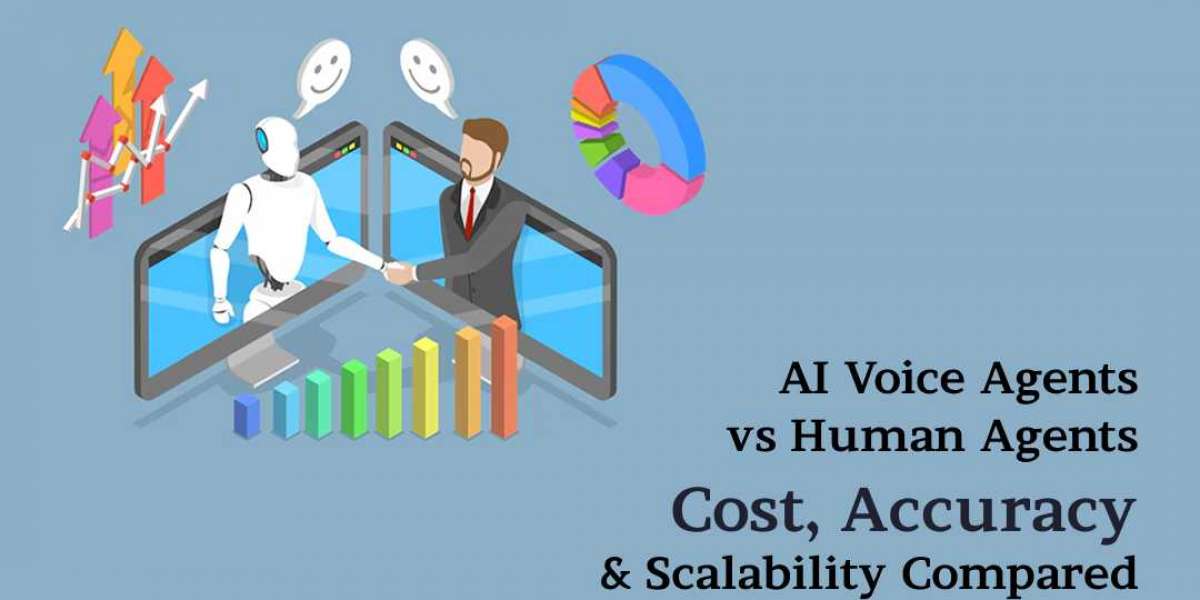The debate is heating up. AI Voice Agents are no longer a futuristic concept—they’re answering calls, resolving queries, and scaling operations across industries. But here’s the question every business leader needs to ask: Are they truly better than human agents?
I’ve worked on both sides of the table—designing AI-driven solutions for contact centers and training human teams. The choice between humans and AI isn’t just about cost. It’s about precision, consistency, empathy, and how fast you want to scale. In this blog, I’ll break down the real differences between AI Voice Agents and human agents across cost, accuracy, and scalability, with clear insights on where each wins—and where each fails.
Let’s compare intelligently. Let’s talk AI Development.
Can AI Voice Agents Actually Save You Money?
Let’s not sugarcoat it—contact centers are expensive.
Human agents require monthly salaries, training programs, infrastructure, benefits, and downtime buffers. On average, a mid-sized business spends ₹35,000–₹50,000 per agent per month in India. Multiply that by 10, 50, or 100 seats—and you’ve got a serious dent in your operating budget.
Now, contrast that with an AI Voice Agent.
Yes, there’s an upfront AI Development cost. But once deployed, these voice agents work 24/7. No breaks, no leave, no sick days. Just pure consistency. And after the first 3–6 months, most companies report cost savings of up to 60% (Source: Deloitte CX Automation Survey 2024).
Accuracy: Can AI Match Human Intelligence?
Here's the truth: humans are intuitive—but not always accurate.
Fatigue, distraction, emotional bias, and poor training can lead to incorrect responses. Even experienced support teams may mishear or misunderstand queries, especially in high-pressure environments.
AI Voice Agents, built with Natural Language Processing (NLP) and Conversational AI, are trained on structured data. They don’t get tired, they don’t skip steps, and they don’t forget compliance scripts. They do, however, depend heavily on data quality and domain tuning.
Let me be real here—AI isn’t perfect. If your system is poorly trained or not customized to your industry, you will get wrong answers. That’s why we always recommend building custom voice agents through strategic AI Development, not relying on out-of-the-box templates.
Real-World Case:
One logistics client at KriraAI switched from a human-heavy support desk to a hybrid model using AI Voice Agents. Within 60 days, accuracy in order tracking calls improved from 84% to 96.5%. Why? Because AI doesn’t forget SKUs or misread statuses.
Verdict:
For structured, repetitive, and process-driven queries, AI Voice Agents outperform in accuracy. For emotional support or nuanced escalations, humans still lead.
Scalability: What Happens When You Need 10x Support?
Imagine it’s festival season and your support volume just tripled.
If you're relying only on humans, your only option is to hire fast—which comes with training delays, inconsistent performance, and a hiring cost spike.
But with AI Voice Agents, you scale instantly.
Need to handle 500 calls simultaneously? No problem. The system simply spawns more instances. That’s the beauty of cloud-native AI Development. You pay for usage, not people.
Example Use Case:
An eCommerce brand during Diwali season used an AI Voice Agent to handle delivery ETA calls. The system managed 80,000+ voice interactions in 3 days—something that would’ve taken 250 human agents on triple shifts.
Scalability isn’t just about volume. It’s about time-to-scale. AI gives you instant elasticity.
Verdict:
For high-volume, seasonal, or growing businesses—AI Voice Agents offer unmatched scalability.
But What About Emotional Intelligence?
Let’s address the elephant in the room: empathy.
Can AI match a human’s ability to calm a frustrated customer or detect emotion in tone?
The answer—for now—is partially.
AI Voice Agents can detect sentiment using speech analysis. They can modulate tone, apologize, and escalate gracefully. But they don’t “feel” your pain. They simulate understanding through trained scripts.
For industries like mental health, premium travel, or high-stakes financial services, humans are still the gold standard. But even there, AI can act as the first layer—handling FAQs and routing real problems to trained staff.
Hybrid Support: Why It’s Not Either-Or
Smart companies don’t choose between AI and humans.
They combine them.
At KriraAI, we build AI Voice Agents that handle 70–80% of routine calls—while intelligently routing complex ones to human agents. This model cuts costs, increases speed, and preserves human empathy where it matters.
This is the future of AI Development in customer support: collaborative automation.
The Hard Truth: AI Is Not Plug-And-Play
I’ve seen businesses install generic voice bots, only to scrap them in 6 months.
Why?
Because AI that’s not domain-trained, linguistically tuned, or context-aware ends up hurting CX more than helping. Customers don’t want to talk to a robot. They want resolutions.
Here’s what you actually need for success:
- A clear voice assistant use-case strategy
- High-quality training data
- Voice model fine-tuning (Indian languages, dialects)
- Escalation mapping and human fallback logic
Want it to work? Custom AI Development is non-negotiable.
Final Thought
This isn’t a man vs. machine story. It’s a story of augmentation.
The smartest businesses in 2025 won’t replace their support teams—they’ll amplify them. AI Voice Agents are already proving their worth in cost, accuracy, and scalability. The only mistake is treating AI like a plugin when it’s actually a long-term capability.







